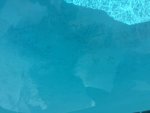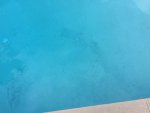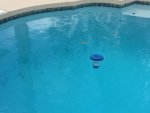Hello,
I am new to the forum. This place is great and I am hopeful to get some great advice.
I will start with my latest test results. I added two gallons of liquid chlorine yesterday so it is still reading high.
FC 10.2
TC 10.8
PH 7.2
TA 91
Hardness 271
CH no info
CYA 60
I am also pretty new to owning a pool. Our pool sat empty for a couple of years after we bought the house. It was in pretty bad condition. We decided to get it up and running for some fun in the sun this year. We hired a contractor to chip out the old plaster, repair some cracks, and then re-plaster with a white plaster. Everything went pretty good. When the contractor was done he put the hose in the bottom of the deep end with a towel wrapped around the end of it. It took about 24 hours to fill.
I was instructed to brush it twice a day for the first week and then once a day for the following weeks and run the pump non-stop until the pool gets clear. I was not given any instruction on what to do with the chemistry of the water. So, I went ahead and brushed the pool as instructed. I searched online for instructions on how to open a pool with new plaster. I opted for the traditional route. If i remember it involved a lot of brushing and vacuuming with a vacuum brush. It was important to use a vacuum brush so the wheels do not compact the plaster dust. Okay, a couple of days go by and the bottom starts to come into view. There was some back-washing involved. I kept an eye on the pressure gauge and back-washed after the needle crept up from 10 to 16 or 18. I also added 64oz of Beautec scale controller. Enough for an initial treatment of 21k gal. I added 5 lbs of CYA and started adding acid. I added two gallons of chlorine but I think it burned off pretty fast because there was not enough CYA. It was still the middle of March so it was not quite hot yet. I probably benefited from the lower temps. I was going to a couple of different pool stores and buying all kinds of chemicals. I know the ph got away from me for about a week or 10 days. I would add 1/2 gal and it would still read high. I would add 1/2 gal the next day and it would still be high. I finally bought 3 cases of acid. I would add 1/2 gal in the morning and 1/2 gal in the evening if it needed it. I just recently got the ph to a normal level.
So, I know the pool was opened poorly. And that brings me to my question. The plaster developed some discoloration over several weeks. I cannot say for sure when it started showing up. I didn't think anything of it because it looked so awesome when the guys finished with it. It was really spectacular. A very brilliant white. Anyway, my wife pointed it out to me and I started to keep an eye on it. It was getting worse. I am now more than concerned. The water is crystal clear and you can see each grey splotch. It is mostly concentrated in the deep end. I have been doing some research and that has left me lost. Any help would be greatly appreciated. I have a meeting with the contractor set for Monday.
I am new to the forum. This place is great and I am hopeful to get some great advice.
I will start with my latest test results. I added two gallons of liquid chlorine yesterday so it is still reading high.
FC 10.2
TC 10.8
PH 7.2
TA 91
Hardness 271
CH no info
CYA 60
I am also pretty new to owning a pool. Our pool sat empty for a couple of years after we bought the house. It was in pretty bad condition. We decided to get it up and running for some fun in the sun this year. We hired a contractor to chip out the old plaster, repair some cracks, and then re-plaster with a white plaster. Everything went pretty good. When the contractor was done he put the hose in the bottom of the deep end with a towel wrapped around the end of it. It took about 24 hours to fill.
I was instructed to brush it twice a day for the first week and then once a day for the following weeks and run the pump non-stop until the pool gets clear. I was not given any instruction on what to do with the chemistry of the water. So, I went ahead and brushed the pool as instructed. I searched online for instructions on how to open a pool with new plaster. I opted for the traditional route. If i remember it involved a lot of brushing and vacuuming with a vacuum brush. It was important to use a vacuum brush so the wheels do not compact the plaster dust. Okay, a couple of days go by and the bottom starts to come into view. There was some back-washing involved. I kept an eye on the pressure gauge and back-washed after the needle crept up from 10 to 16 or 18. I also added 64oz of Beautec scale controller. Enough for an initial treatment of 21k gal. I added 5 lbs of CYA and started adding acid. I added two gallons of chlorine but I think it burned off pretty fast because there was not enough CYA. It was still the middle of March so it was not quite hot yet. I probably benefited from the lower temps. I was going to a couple of different pool stores and buying all kinds of chemicals. I know the ph got away from me for about a week or 10 days. I would add 1/2 gal and it would still read high. I would add 1/2 gal the next day and it would still be high. I finally bought 3 cases of acid. I would add 1/2 gal in the morning and 1/2 gal in the evening if it needed it. I just recently got the ph to a normal level.
So, I know the pool was opened poorly. And that brings me to my question. The plaster developed some discoloration over several weeks. I cannot say for sure when it started showing up. I didn't think anything of it because it looked so awesome when the guys finished with it. It was really spectacular. A very brilliant white. Anyway, my wife pointed it out to me and I started to keep an eye on it. It was getting worse. I am now more than concerned. The water is crystal clear and you can see each grey splotch. It is mostly concentrated in the deep end. I have been doing some research and that has left me lost. Any help would be greatly appreciated. I have a meeting with the contractor set for Monday.




